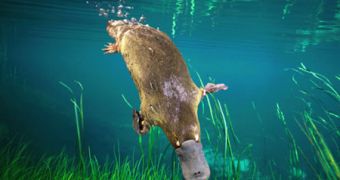1. The platypus represents one of the most peculiar living mammals. And beyond peculiarity, it is really the most primitive living mammal, together with its relatives, the echidnas, forming the group Monotrema ("one orifice", as they have only the cloaca). They have many traits still common to reptiles, but not found in mammals, like a cloaca or a third bone in the shoulder girdle, the coracoid (which in the other mammals is fused with the shoulder blade. Also, the platypus lays eggs like the reptiles, which are incubated in a nest.
2. The beak of the platypus, despite its resemblance with that of a duck, is not horny like in birds, but covered with sensitive skin. In fact, the skin of the beak can detect slight variations of the electromagnetic field of the underwater animals, and this way, even a blind platypus can eat very well. The animal feast on aquatic invertebrates (from worms and insects to crayfish) and tadpoles.
3. Platypuses dig burrows with two entrances: one into the ground and one underwater. Inside the den, the platypus builds a nest which is sheathed with eucalyptus leaves, grass, twigs and reed. The eggs are incubated by the female for two weeks. The offspring feed on the milk secreted by the mammary glands and seeping along the hairs, as platypuses do not have tits, like the other mammals.
4. The male platypus and a few species of shrews are the only known venomous mammals. The venom is injected by a large spur located on the rear limb and its effects are quite nasty for the people.
5. Platypus and cetaceans (whales and dolphins) are the only known mammals that do not dream. Cetaceans, because of the sea life; the platypus, because of the simple structure of its brain cortex.
6. Platypus and marsupials lack the XIST gene, which, in all the other mammals, is essential in the process of inactivating the supplementary X chromosome in females.
7. Human penis ends with a head called gland. This is also the case of most species. But platypuses and echidnas have bifurcated penises. The bifurcated penises are formed by two distinct columns and so the penis has four heads! The penis is not used for urination and it only gets out of the body during mating (the penis is kept, while resting, in the cloaca). Males ejaculate with just two heads (half of the penis) at a time!
8. The oldest platypus has just been found in southeast Australia: Teinolophos. It is 112-122 Ma old. This means that the echidna-platypus separation is much older than 122 million years. Teinolophos even had the electro-sensitive "bill" for detecting aquatic prey. Previously, researches thought that monotremes separated from the other mammals just 93 Ma ago!

 14 DAY TRIAL //
14 DAY TRIAL //